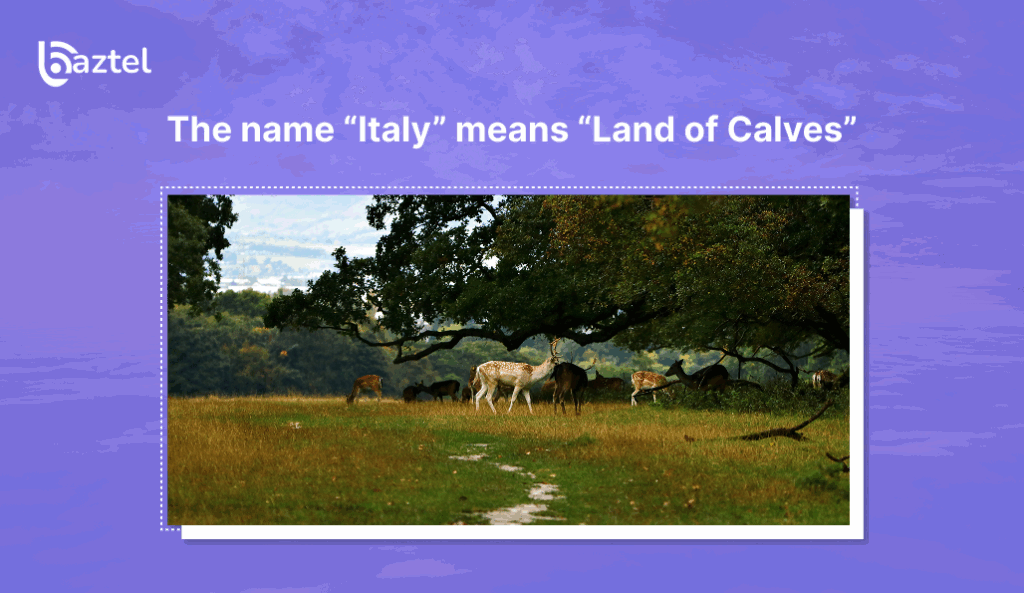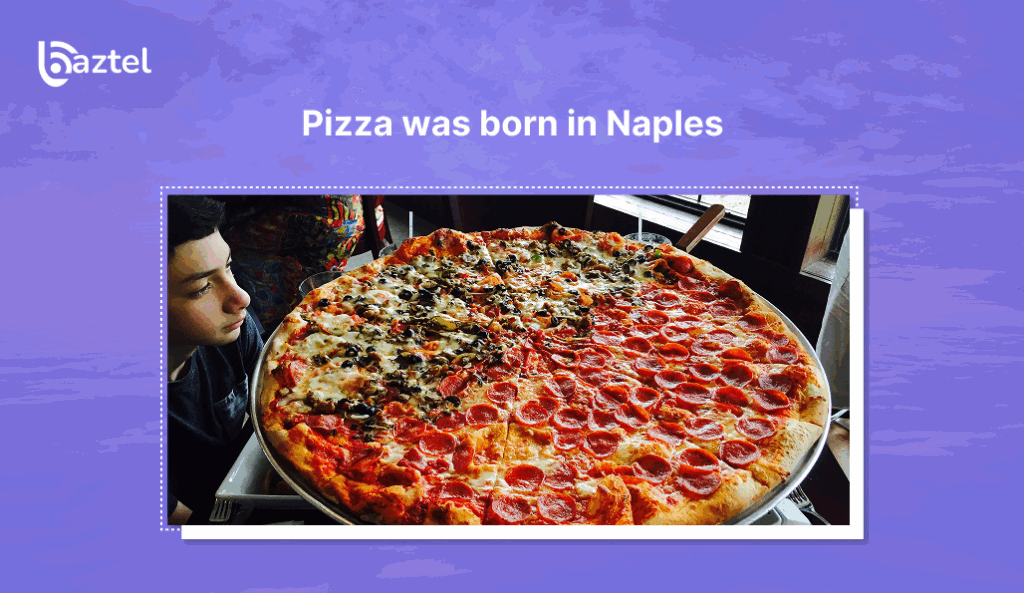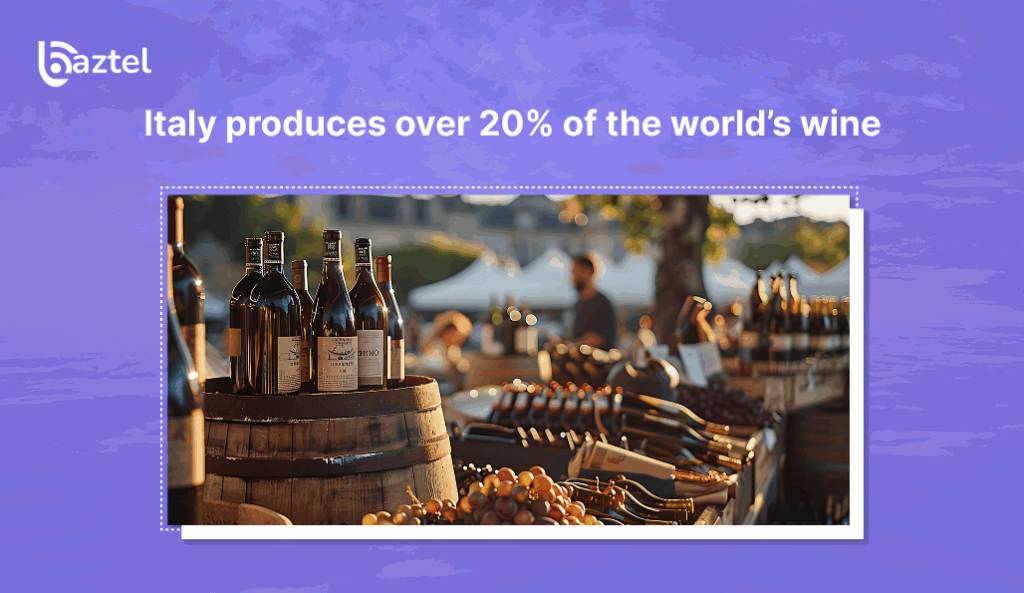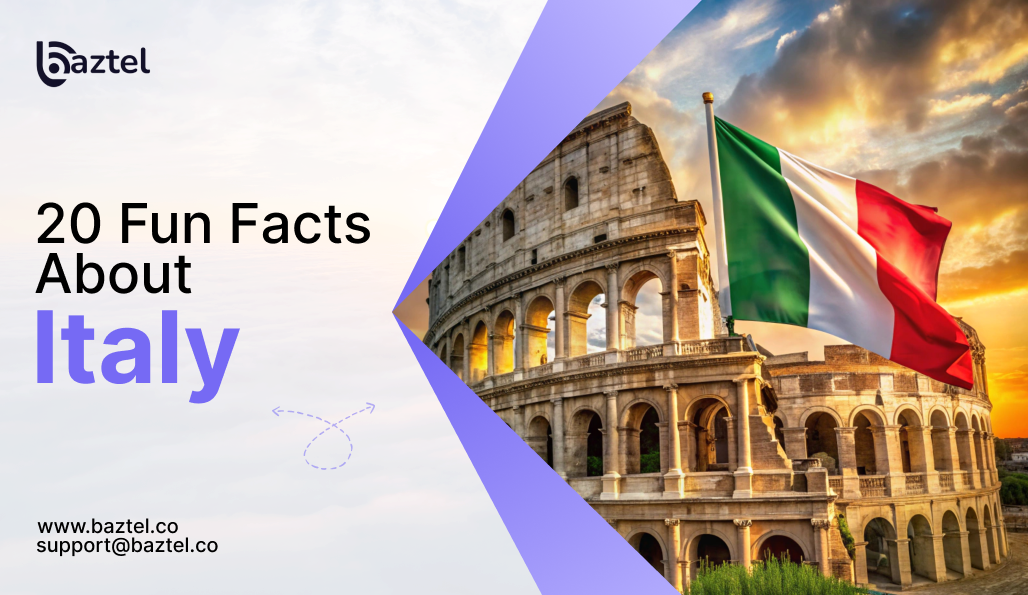Italy is a country with a lot of fascination, and actually, a lot of people put it as the number one most captivating country. Among all, it is known for its remarkable art, history, excellent food and lovely places that always keep their charm. The magnificence of Rome, the allure of Venice, and the uniqueness of every place in Italy to some extent are some of the things that every tourist will experience. Nevertheless, Italy has also hidden many wonderful and delightful details that are not so well-known that it is still the most exceptional in the world.
In this blog, we will talk about the 20 Fun Facts About Italy that are not so obvious, providing you with interesting views into its customs, inventions, and lifestyle. Italy’s impact could not be less, whether it is the origin of pizza, opera, or the Renaissance period. These fun facts are going to make your appreciation for this classic and amazing nation grow even more, regardless of whether it is your first trip to Italy or you are returning for another visit.
Top 20 Fun Facts About Italy
Italy is full of surprises, and the following facts will catch your attention. The Fun Facts About Italy is a jovial and informative journey that will lead you across the globe in four steps: nationalities, cuisines, metropolitan areas, and customs. From ancient history to modern life, every fact shows why Italy is such a beautiful and special country to visit.
1. The name “Italy” means “Land of Calves”

Italy’s name is based on the Latin term “vitulus” that is translated as “calf” in English. The people from the southern part of Italy, who had been using the bull as a symbol of fecundity and prosperity, were definitely the ones who had a major role in giving the name to the land.. This fact also recalls the time when Italy was mainly an agricultural region.
- Derived from ancient Latin origins
- Symbolizes cattle, fertility, and abundance
- Reflects early tribal traditions
- Connects Italy to its rural past
- A unique meaning behind a global name
2. Italy is shaped like a boot
Italy looks like a boot and goes out into the Mediterranean Sea, which makes its coastline very long. Due to its shape and the different areas inside it, Italy is among the simplest countries to be found on a map.
- The “boot” shape extends 1,130 km southward
- Sicily appears like a “football” being kicked
- Provides vast coastal access
- Influences regional climate patterns
- A globally iconic map outline
3. Italy became a unified country only in 1861
Italy was a mosaic of distinct kingdoms and city-states, including Venice, Florence, and Naples, before 1861. The rule was done by different governments, and people spoke differently in these regions. The joining together of states under King Victor Emmanuel II was the beginning of the new Italian nation.
- Unified under the Kingdom of Italy
- Led by King Victor Emmanuel II
- Strong regional identities remain
- Many dialects still exist
- Modern Italy is relatively young
4. Two countries exist inside Italy
In fact, the Italian territory is home to two different countries: Vatican City and San Marino. The former is even recognized as the world’s smallest country, while the latter is one of the oldest republics still around and dates back to the 4th century.
- Vatican City houses the Pope
- San Marino has ancient governance
- Both maintain full independence
- Surrounded completely by Italy
- Popular tourist attractions
5. Italy has the most UNESCO World Heritage Sites
Italy has the highest number, more than 50 of UNESCO World Heritage Sites that are a fabulous combination of the old, the Renaissance cities, the churches, and the natural areas, which narrate the story of the country’s cultural richness.
- More than 50 UNESCO sites across the country
- Incorporates art, architecture and nature
- Venice, Florence and Rome are the main attractions
- Reflects centuries of civilization
- A global leader in preservation
6. Italy has three active volcanoes

In Europe, the most visible is the fiery ordeal of Mount Etna in Sicily, the most voluminous and frequent of its kind in the last five centuries. Other active volcanoes include Stromboli and Vesuvius in Italy, notably.
- Though the tallest active volcano in Europe, Etna has not been quiet yet
- Pompeii was buried under volcanic ash in 79 AD due to the eruption of Vesuvius
- Stromboli is almost constantly erupting
- Volcanic soil supports rich agriculture
- Major geological attraction
7. Rome is older than most countries
It is hard to believe, but Rome, a city that was founded in 753 BC, is still considered one of the oldest cities with the longest and most fascinating history of almost 2,800 years. The Colosseum is one of the great pieces of architecture that explains the empires that had global dominion. Forum ruins also are there.
- Legendary founders Romulus and Remus
- Once ruled the known world
- Home to priceless architecture
- Heart of the ancient Roman Empire
- A living museum of history
8. The first modern bank was Italian
The Bank of San Giorgio, founded in 1407 at the Italian city of Genoa, is considered one of the world’s oldest banks. Early initiators of trade finance, banking, and double-entry bookkeeping were Italian merchants, modern and ubiquitous practices today.
- Founded at Genoa in 1407
- Developed into current financial systems
- Funded Mediterranean trade routes
- Influenced banking across Europe
- Foundation of global finance
9. Italians invented eyeglasses

In the North of Italy around the year 1280, eyeglasses were invented to assist monks and scholars in reading manuscripts. The invention radically transformed learning and knowledge in the sciences, quickly circulating in Europe and changing the way people learned and worked.
- Created for monks and readers
- First recorded in Pisa and Venice
- Sparked a literacy revolution
- Spread through Europe by traders
- Early proof of Italian innovation
10. The Italian flag has symbolic colors
The Italian flag’s green, white, and red stand for hope, faith, and charity. Or, some say they represent Italy itself: green for the plains, white for the Alps’ snow, and red for the blood spilled uniting the country.
- Inspired by the French tricolor
- Adopted in 1797
- Represents unity and sacrifice
- Symbol of modern Italian pride
- Recognized worldwide
11. Pizza was born in Naples

Pizza, by now a worldwide preference, unfolded its history in the 18th century in Naples. Margherita pizza, comprising tomatoes, mozzarella, and basil, signifies the national colors of Italy and its creation was linked to Queen Margherita of Savoy.
- Invented in Naples, southern Italy
- Symbolizes Italian flag colors
- Became popular in the 1800s
- Spread worldwide in the 20th century
- National culinary symbol
12. Italians take coffee culture seriously
In Italy, coffee is one of the essentials of life. You will not see anyone having cappuccino after lunch, as it is only a morning drink, while espresso is the king of the day. People, as a rule, take it in a quick shot at the bar counter: a short, social, and strong moment, the Italian style.
- Cappuccino only before 11 a.m.
- Espresso is Italy’s favorite drink
- Coffee bars on every corner
- Quick yet social experience
- Ritual of Italian daily life
13. Italians throw coins into the Trevi Fountain for luck
Legend says throwing a coin into Rome’s Trevi Fountain ensures your return to the city. Visitors toss nearly one million euros a year, which is collected and donated to local charities.
- Located in central Rome
- Designed by Nicola Salvi
- Coin toss over right shoulder
- Supports community aid programs
- One of Italy’s top attractions
14. The Leaning Tower of Pisa wasn’t meant to lean
Built in 1173, the tower began tilting due to unstable soil. Engineers tried several fixes over centuries, but the lean became iconic. Today, it safely leans about 4 degrees and attracts millions of tourists.
- Construction took 200 years
- Stands 56 meters tall
- Tilt caused by soft ground
- Stabilized in the 1990s
- Global symbol of Italy
15. Italy produces over 20% of the world’s wine

Italy is the largest wine producer globally, contributing around 20% of the world’s total. With hundreds of native grapes, every region offers a distinct flavor from Chianti to Prosecco and Barolo.
- Over 350 grape varieties
- Major regions: Tuscany, Veneto, Piedmont
- Wine integrated with daily meals
- Hosts global wine festivals
- Symbol of Italian craftsmanship
16. Italy has more than 1,500 lakes
Italy’s diverse landscape includes alpine, volcanic, and glacial lakes. Lake Como, Lake Garda, and Lake Maggiore are the most famous, offering stunning scenery, boating, and luxury resorts for visitors.
- Lakes spread across all regions
- Lake Como is Italy’s deepest
- Provide hydroelectric power
- Popular for tourism and fishing
- Offer breathtaking mountain views
17. Venice is built on 118 islands
Venice is spread across 118 small islands interconnected by over 400 bridges. A city built on wooden supports in a lagoon, it is both an architectural wonder and one of the most romantic places on earth.
- Connected by canals, not roads
- Famous for gondola rides
- Known as “The Floating City”
- Built on wooden piles
- UNESCO World Heritage Site
18. Italy is home to the world’s oldest university
The University of Bologna started way back in 1088, making it the oldest university still running today. It really shaped how universities work by creating degrees and organizing how things are taught.
- Established in the Middle Ages
- Introduced structured curriculum
- Alumni include Dante and Petrarch
- Basis for global education systems
- Still active today
19. Italians invented musical notation and opera
Music terms like “piano,” “forte,” and “allegro” are Italian because Italy gave birth to modern musical notation and opera. Composers such as Verdi and Puccini revolutionized music worldwide.
- Opera began in Florence in the 1500s
- Italian music spread across Europe
- Many instruments originated here
- Strong cultural contribution
- Italy remains music’s emotional home
20. The Renaissance was born in Italy
The Renaissance, which translates as “rebirth,” was a 14th-century cultural and intellectual movement that started in Italy. The Renaissance was a major burst of culture in art, science, and philosophy the world saw for the first time, and it was largely due to this kind of brilliance of Leonardo da Vinci and Michelangelo that it spread to the whole human civilization and changed it forever.
- Originated in Florence
- Revolutionized art and science
- Inspired global creativity
- Produced timeless masterpieces
- Defined European identity
Travel Tips & Bonus Highlights
Traveling in Italy is a dream, and with the right equipment, it becomes easier. Staying connected is essential for navigation, translation or sharing experiences. The easiest way to do that is by using an eSIM for Italy.
Why Use an eSIM in Italy

Conclusion
Italy is not merely a land but rather an eternal museum, a paradise for food, and, in a way, a feat of culture too. Italy sure knows how to enchant its visitors! I will just name a few of the greatest hits in the country: pizza, opera, ancient ruins, and beautiful Renaissance art. It’s also just a country of creativity and passion; always the roots. The Spanish conquistadors certainly with boots on fire stepped onto the American shores in 1492. You will surely get me if you walk around Florence with its cobbled streets or even ride on a gondola in Venice. Anyway, if you want your trip to be smooth sailing, then Baztel eSIM is the ticket. Convenient, economical, and tailor-made for hassle-free explorers!
FAQs
1. What is Italy famous for?
Italy is still a source of surprise and inspiration for many people today. One reason for this is the country’s long history, world-class art, and the mention of food, the last word in fashion, and its wonderful architecture. Moreover, it is proud of its still-living ancient constructions such as the Colosseum in Rome, the romantic canals in Venice, and the Vatican City, which is the heart of global Christianity and culture.
2. What is the best time to visit Italy?
Spring and fall are the best seasons to go to Italy. To be more specific, the months from April to June and from September to October will provide you with quiet weather and not so many tourists and such beautiful views that you will be able to discover ancient towns, vineyards and beach areas without any inconvenience caused by the heat or the crowds of summer.
3. What are the options for using mobile data in Italy?
Impeccable mobile data service in Italy by Baztel eSIM provides the customer with an easy and seamless experience. It enables the execution of eSIM digitally right away without the need for a physical SIM card to be done away with, hence giving the traveler quick, inexpensive, and safe Internet not only in important spots of Italy but also in nearby European countries.
4. What are the must-try dishes of Italy?
Italian food has an excellent variety and is good from all regions. The world can’t sum up Neapolitan pizza in Naples, carbonara pasta in Rome, creamy risotto in Milan, or real gelato anywhere. Every one of these dishes is a door through which one can enter the local sturdy character, customs, and great culinary art that has made the Italian gastronomic world famous and one of the most difficult to define.
5. Is it too much for an average traveler to visit Italy?
Italy is a country full of wonders for every kind of person. It’s true that cities such as Milan and Venice may cost a lot of money; however, even in these highly frequented areas, a decent price for accommodation and food can be found if you make a thorough search. A great trip to Italy on a tight budget is still possible if you make your plan wisely, eat at local restaurants, and buy an inexpensive eSIM.
Blog Author
Peter
Peter started BazTel.co to make mobile internet easier for travellers. He noticed how tough it was to find good network options while visiting new countries. That’s when he built BazTel — a place where anyone can buy eSIMs online without confusion or long steps. He believes tech should be simple and useful, not complicated. When he’s free, he likes to travel, test BazTel himself, and keep improving it based on real user problems.

 Botswana
Botswana Zambia
Zambia Congo
Congo Colombia
Colombia China mainland
China mainland Chile
Chile Chad
Chad Central African Republic
Central African Republic Canada
Canada Cameroon
Cameroon Cambodia
Cambodia Burkina Faso
Burkina Faso Bulgaria
Bulgaria Brunei Darussalam
Brunei Darussalam Brazil
Brazil Aland Islands
Aland Islands Bosnia and Herzegovina
Bosnia and Herzegovina Bolivia
Bolivia Belgium
Belgium Belarus
Belarus Bangladesh
Bangladesh Bahrain
Bahrain Azerbaijan
Azerbaijan Austria
Austria Australia
Australia Armenia
Armenia Argentina
Argentina Algeria
Algeria


